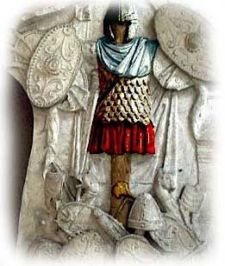Civilian dress (for women):
None of the antique authors offers any information on what women wore. On the well-known figurative monuments (the Column in Rome and the monument in Adamclisi), the women and depicted in long dresses, some also wearing richly folded mantles, represented according to the classical conventions, looking like long hitons. On their heads they wear headkerchiefs tied at the back, under their hair caught in a bunch and when they are note barefoot, they are shown wearing shoes similar to those of men..
The main trait of the shirt worn by women is its numerous folds at the neck, tied with a cord or covered by a narrow collar. Its sleeves can be either long or short. There was also another type of shirt, with low-cut neckline and folds tied under a bandeau running around the edges, placed in the front, in the center. These latter shirts were made of very thin cloth. .
As for thw hairdresses of Dacian women, on the Column they have their heads covered, but on the monument in Adamclisi, their hair is combed neatly, split in two on the middle and tied in a bundle at the back of the head. Similar hairdresses can be noted on the phalerae discovered in Herăstrău and Ikimovo or on the fibulae from Coada Malului, Bălăneşti and an unknown location in Transylvania. The female characters on the plaques in Letniţa wear their hair cut rather short, tied at the back. In other cases, their hair is long, framing their face and flowing down to the shoulders. Another hair dress consists of the hair slit in two and braided in two long pleats (seen for example on the phalerae from Galice or Lupu).
The only antique written source referring to the color of Dacian clothes is Aristophanes, who speaks of the fact that “those living near the Istros … wear colorful clothes”. Such was probably the case mostly with women.
When dealing with Dacian dress and costume, one should mention their jewelry and accessories. Women are depicted on both sculptural monuments mentioned above, as wearing no bodily decorations, but on antique metal objects created by the Dacians themselves, some pieces of jewelry are visible, while others have been discovered during archaeological excavations. The best known are the fibulae (with knobs), most made of silver. Around their necks, the Dacians wore one or more necklaces, made of simple or twisted metal bars. They also decorated themselves with necklaces made of silver, bronze or glass beads (the latter monochrome, polychrome or colored in “peacock eye” patterns), of various shapes and sizes. On their upper arms, the Dacian wore bracelets made of multiple spires, worked of thick silver wire coiled in three, four, or even more spires. The loose ends of such bracelets were modeled in the shape of snake heads and palm leaf-like decorations. One must mention that men also wore such items of jewelry.
Among the pieces probably worn by both men and women, one must also enumerate: ornamental silver chain necklaces (probably as a display of noble status), bracelets (to be worn on the forearm, made of iron, bronze, and silver), silver and gold rings (some ending in snake heads), earrings (not very numerous among the finds), bronze pendants and phalerae (made of silver or gilt silver). Such jewels certainly belonged to representatives of the upper class, of the aristocracy, consisting of another proof of the existence of different social strata among the Dacians.



 ::Reenactment resources::
::Reenactment resources::

